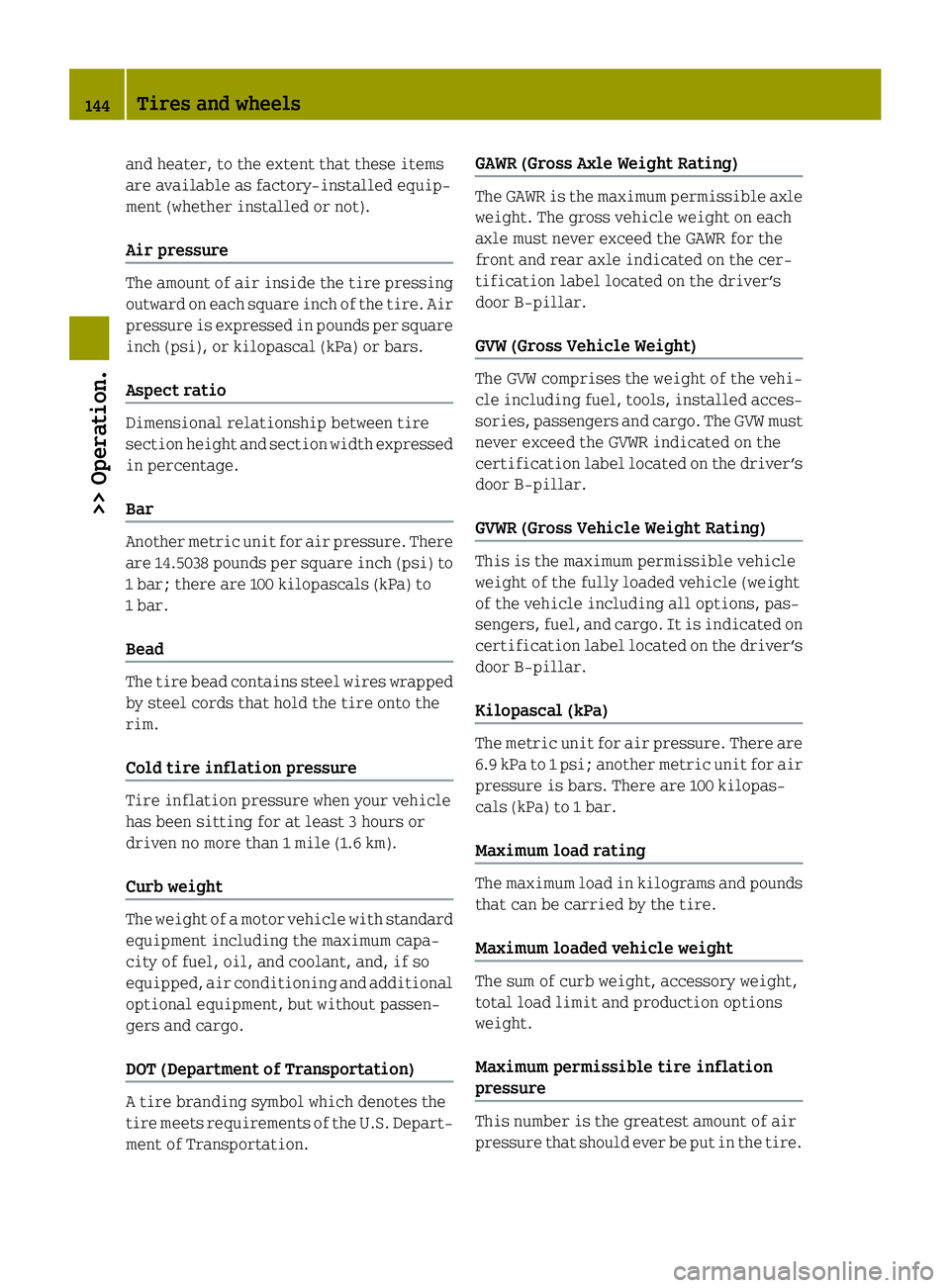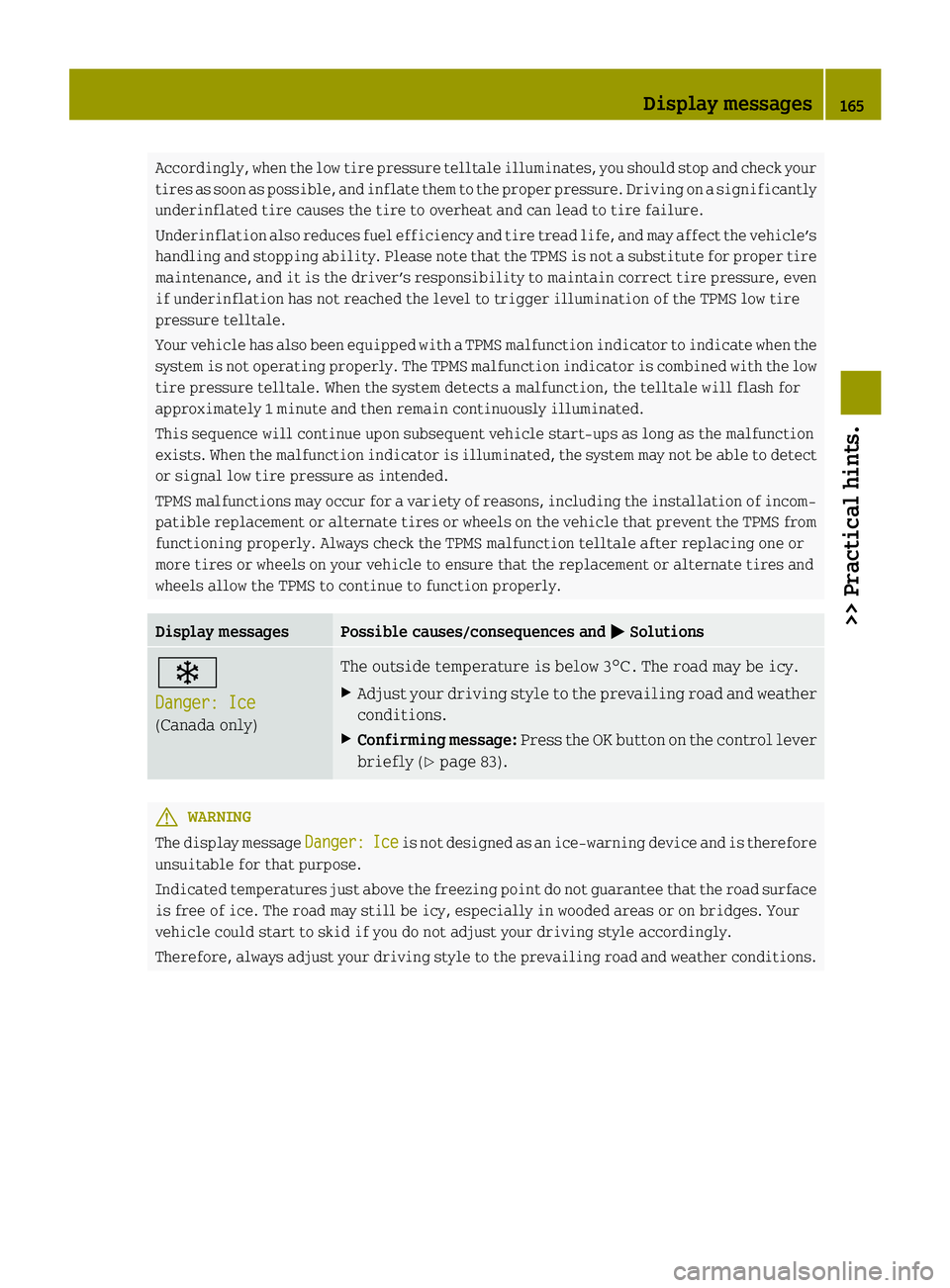fuel pressure SMART FORTWO COUPE ELECTRIC DRIVE 2015 Owners Manual
[x] Cancel search | Manufacturer: SMART, Model Year: 2015, Model line: FORTWO COUPE ELECTRIC DRIVE, Model: SMART FORTWO COUPE ELECTRIC DRIVE 2015Pages: 222, PDF Size: 5.02 MB
Page 146 of 222

and heater, to the extent that these items
are available as factory-installed equip-
ment (whether installed or not).
Air pressure The amount of air inside the tire pressing
outward on each square inch of the tire. Air pressure is expressed in pounds per square
inch (psi), or kilopascal (kPa) or bars.
Aspect ratio Dimensional relationship between tire
section height and section width expressed
in percentage.
Bar Another metric unit for air pressure. There
are 14.5038 pounds per square inch (psi) to
1 bar; there are 100 kilopascals (kPa) to
1 bar.
Bead The tire bead contains steel wires wrapped
by steel cords that hold the tire onto the
rim.
Cold tire inflation pressure Tire inflation pressure when your vehicle
has been sitting for at least 3 hours or
driven no more than 1 mile (1.6 km).
Curb weight The weight of a motor vehicle with standard
equipment including the maximum capa-
city of fuel, oil, and coolant, and, if so
equipped, air conditioning and additionaloptional equipment, but without passen-
gers and cargo.
DOT (Department of Transportation) A tire branding symbol which denotes the
tire meets requirements of the U.S. Depart- ment of Transportation. GAWR (Gross Axle Weight Rating) The GAWR is the maximum permissible axle
weight. The gross vehicle weight on each
axle must never exceed the GAWR for the
front and rear axle indicated on the cer-
tification label located on the driver’s
door B‑pillar.
GVW (Gross Vehicle Weight) The GVW comprises the weight of the vehi-
cle including fuel, tools, installed acces-
sories, passengers and cargo. The GVW must never exceed the GVWR indicated on the
certification label located on the driver’s
door B‑pillar.
GVWR (Gross Vehicle Weight Rating) This is the maximum permissible vehicle
weight of the fully loaded vehicle (weight
of the vehicle including all options, pas-
sengers, fuel, and cargo. It is indicated on
certification label located on the driver’s door B‑pillar.
Kilopascal (kPa) The metric unit for air pressure. There are
6.9 kPa to 1 psi; another metric unit for air
pressure is bars. There are 100 kilopas-
cals (kPa) to 1 bar.
Maximum load rating The maximum load in kilograms and pounds
that can be carried by the tire.
Maximum loaded vehicle weight The sum of curb weight, accessory weight,
total load limit and production options
weight.
Maximum permissible tire inflation
pressure This number is the greatest amount of air
pressure that should ever be put in the tire.144
Tires and wheels>> Operation.
Page 167 of 222

Accordingly, when the low tire pressure telltale illuminates, you should stop and check your
tires as soon as possible, and inflate them to the proper pressure. Driving on a significantly underinflated tire causes the tire to overheat and can lead to tire failure.
Underinflation also reduces fuel efficiency and tire tread life, and may affect the vehicle’s
handling and stopping ability. Please note that the TPMS is not a substitute for proper tire maintenance, and it is the driver’s responsibility to maintain correct tire pressure, even
if underinflation has not reached the level to trigger illumination of the TPMS low tire
pressure telltale.
Your vehicle has also been equipped with a TPMS malfunction indicator to indicate when the
system is not operating properly. The TPMS malfunction indicator is combined with the low tire pressure telltale. When the system detects a malfunction, the telltale will flash for
approximately 1 minute and then remain continuously illuminated.
This sequence will continue upon subsequent vehicle start-ups as long as the malfunction
exists. When the malfunction indicator is illuminated, the system may not be able to detect or signal low tire pressure as intended.
TPMS malfunctions may occur for a variety of reasons, including the installation of incom-
patible replacement or alternate tires or wheels on the vehicle that prevent the TPMS from functioning properly. Always check the TPMS malfunction telltale after replacing one or
more tires or wheels on your vehicle to ensure that the replacement or alternate tires and
wheels allow the TPMS to continue to function properly. Display messages Possible causes/consequences and
M MSolutions Ò
Danger: Ice Danger: Ice
(Canada only) The outside temperature is below 3
¥. The road may be icy.
X Adjust your driving style to the prevailing road and weather
conditions.
X Confirming message: Press the OK button on the control lever
briefly (Y page 83). G
WARNING
The display message Danger: Danger:Ice
Iceis not designed as an ice-warning device and is therefore
unsuitable for that purpose.
Indicated temperatures just above the freezing point do not guarantee that the road surface
is free of ice. The road may still be icy, especially in wooded areas or on bridges. Your
vehicle could start to skid if you do not adjust your driving style accordingly.
Therefore, always adjust your driving style to the prevailing road and weather conditions. Display messages
165>> Practical hints. Z